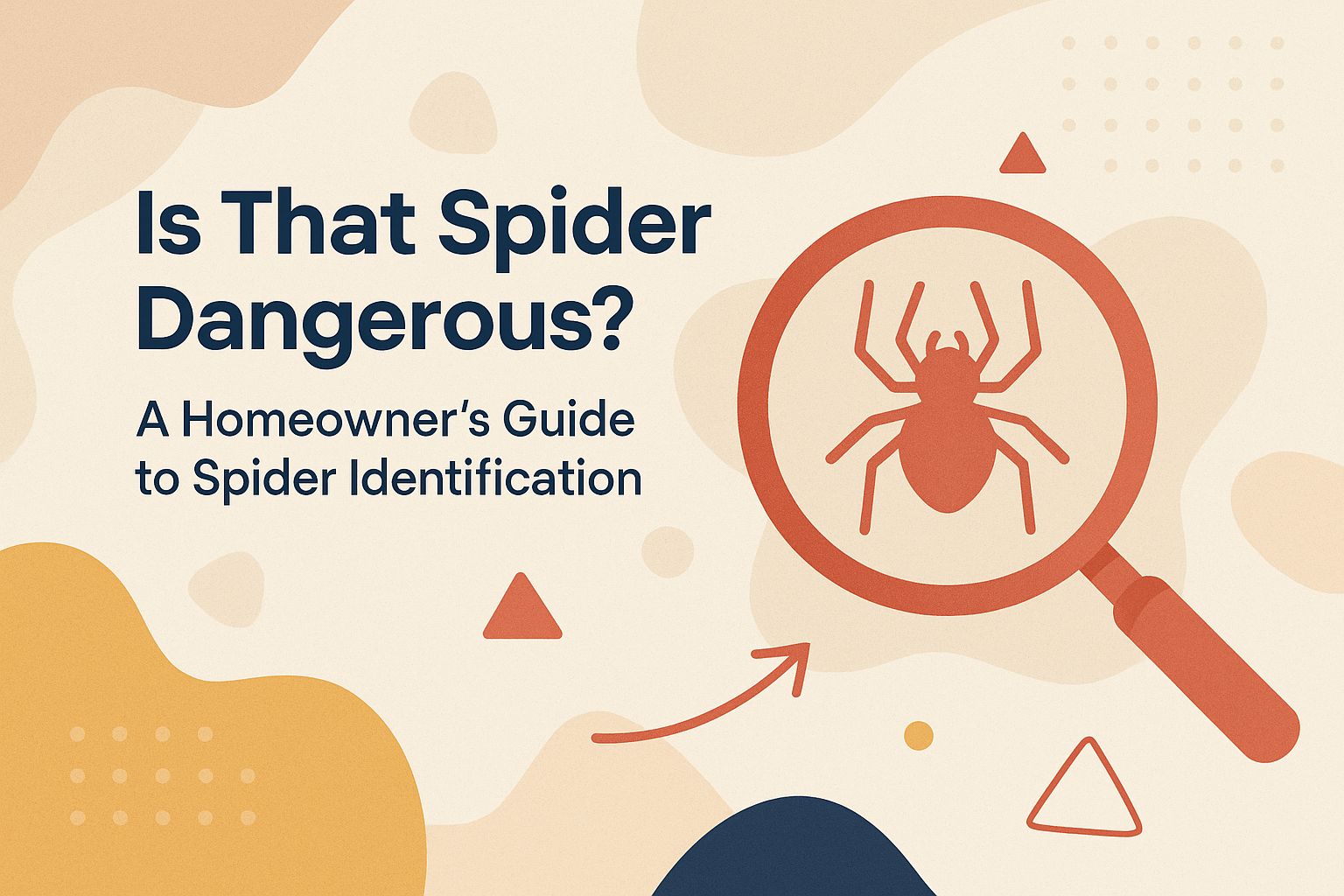
Is That Spider Dangerous? A Homeowner’s Guide to Spider Identification
A spider moves quickly across your floor, and you feel anxious-should you be concerned? Recognizing spiders is important for all homeowners. This homeowner’s guide dives into spider anatomy, common myths, and the types of spiders lurking in your home. You’ll learn to distinguish between harmless visitors and dangerous spiders that could pose a threat. Curious about your eight-legged guests? Let’s learn how to identify spiders together.
Importance of Identifying Spiders
Knowing how to recognize spiders correctly can help people prevent harmful situations and use successful methods for spider control and pest management.
In urban areas, approximately 2,000 spider bites are reported annually, highlighting the importance of awareness.
For example, you can recognize the black widow by its shiny black body and red hourglass mark. Homeowners should familiarize themselves with this species as well as the brown recluse, which features a violin-shaped marking on its back. For an extensive analysis of this trend, our comprehensive guide on identifying dangerous spiders examines safety measures crucial for any household.
Apps like Seek or iNaturalist can quickly tell you the names of spiders and other species. Knowing these spiders’ hiding spots, such as dark corners or basements, enables more effective prevention measures.
Common Misconceptions About Spiders
Many people believe that all spiders are dangerous, leading to unnecessary fear and often harmful extermination methods.
In reality, only a small number of spider species pose any threat to humans. For example, the black widow and brown recluse can potentially cause harm, but most spiders are harmless and actually beneficial.
Here are common myths debunked:
- Not all spiders bite; many prefer to flee.
- Spiders are also not pests; they help control insect populations.
- Spiders are not dirty creatures; they can clean up their environments by preying on flies and other pests.
Knowing these facts can promote living together instead of elimination.
Spider Body Structure and Life Stages
Studying spider body structure helps in identifying spiders because each type has unique physical traits relevant to spider taxonomy.
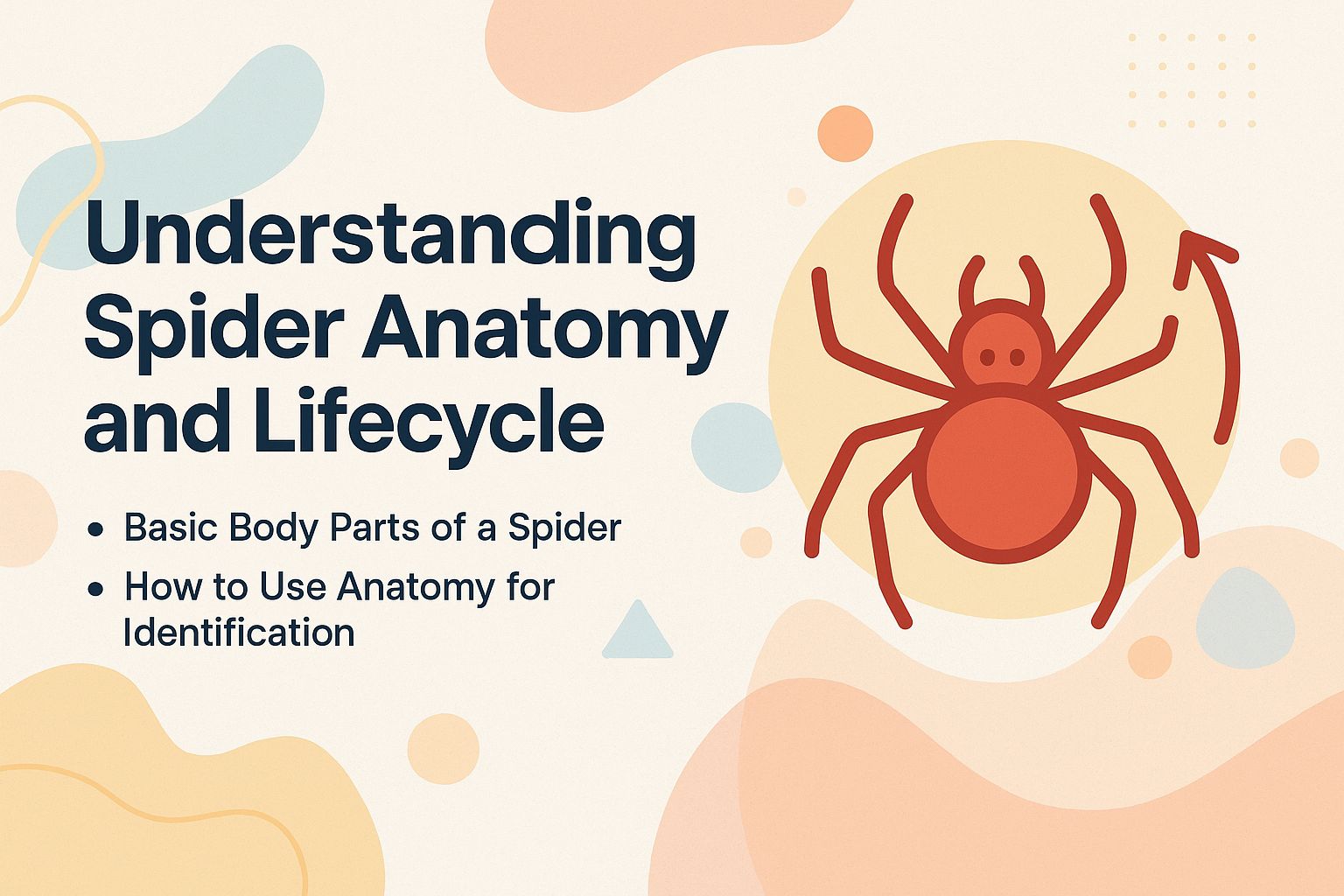
Basic Body Parts of a Spider
Key body parts integral to spider identification include the cephalothorax, abdomen, and legs, each varying significantly by species.
The front part of the spider’s body contains its eyes, mouth, and legs. This area is important for a correct examination. For example, the garden spider typically has a wider, flattened cephalothorax.
The abdomen, or opisthosoma, varies in size and shape, often exhibiting distinct patterns which can help differentiate species. The legs, which can be long and thin or short and strong, are used for tasks like catching prey and creating webs.
Diagrams showing various species can help in recognizing them, especially common ones like the orb-weaver.
How to Use Anatomy for Identification
To identify a spider, focus on unique anatomical features like leg length, body coloration, and specific markings that distinguish species.
Begin by observing the spider’s leg length relative to its body size; long, slender legs often indicate a species like the wolf spider.
Next, look at the colors-many orb-weavers have bright patterns.
Use a checklist: check leg length, observe body patterns, and record any unique markings.
To find out about various plants and animals, use apps like ‘Seek by iNaturalist.’ You can upload photos and quickly get information.
This combination of anatomical observation and technology provides a reliable method to determine spider species.
Identifying Common Household Spiders
Knowing whether indoor spiders are harmful or harmless is important for staying safe. If you need guidance on recognizing dangerous species, consider reviewing our comprehensive guide on identifying dangerous spiders. This resource can provide peace of mind and ensure your safety at home.

Common Non-Dangerous Spiders
Common non-dangerous spiders such as the garden spider and cellar spider are often harmless and beneficial for pest control.
Many harmless spiders, such as garden spiders and backyard spiders, are important for ecosystems.
For instance, the garden spider, usually found in gardens and meadows, helps control aphid populations by preying on them.
The cellar spider likes dark corners of homes, where it eats houseflies and other insects, helping control pests naturally.
The jump spider, famous for its excellent eyesight, is often seen on walls and trees, where it looks for small insects to catch.
The orb-weaver is recognizable by its circular webs and is commonly found in gardens and forests, where it captures various flying pests, thus maintaining the balance in local ecosystems.
Common Dangerous Spiders
Knowing which spiders can harm you, such as the black widow and brown recluse, is important for keeping your family safe.
Two particularly dangerous spiders are the black widow and the brown recluse.
The black widow is identifiable by its glossy black body and the distinctive red hourglass marking on its abdomen. It typically resides in dark, undisturbed areas like woodpiles and sheds. Bites can cause significant pain, muscle cramps, and neurologic symptoms.
The brown recluse, on the other hand, has a tan body with a dark violin-shaped marking on its back. It likes quiet places like attics and basements. Its bite can cause serious skin damage.
Immediate medical attention is recommended for both types of bites.

Visual Identification Tips
Using visual guides can greatly improve your skill in quickly and correctly recognizing different types of spiders.
Start by observing their distinctive features, such as body color patterns, size, and web structure. For example, the orb-weaver spider often shows bright colors and complex webs, while wolf spiders are usually brown and do not have a visible web.
Creating a checklist can aid in this process: include categories for size (small, medium, large), coloring (striped, solid, mottled), and habitat (woodlands, gardens, indoors).
Books such as the ‘Peterson Field Guide to Spiders’ are very useful, providing clear images and explanations to help you identify various spiders.
Spider Behavior and Habitat
Spiders show different behaviors, such as spider mating behavior and hunting techniques, and live in various places. Knowing these details helps in recognizing and handling them properly.
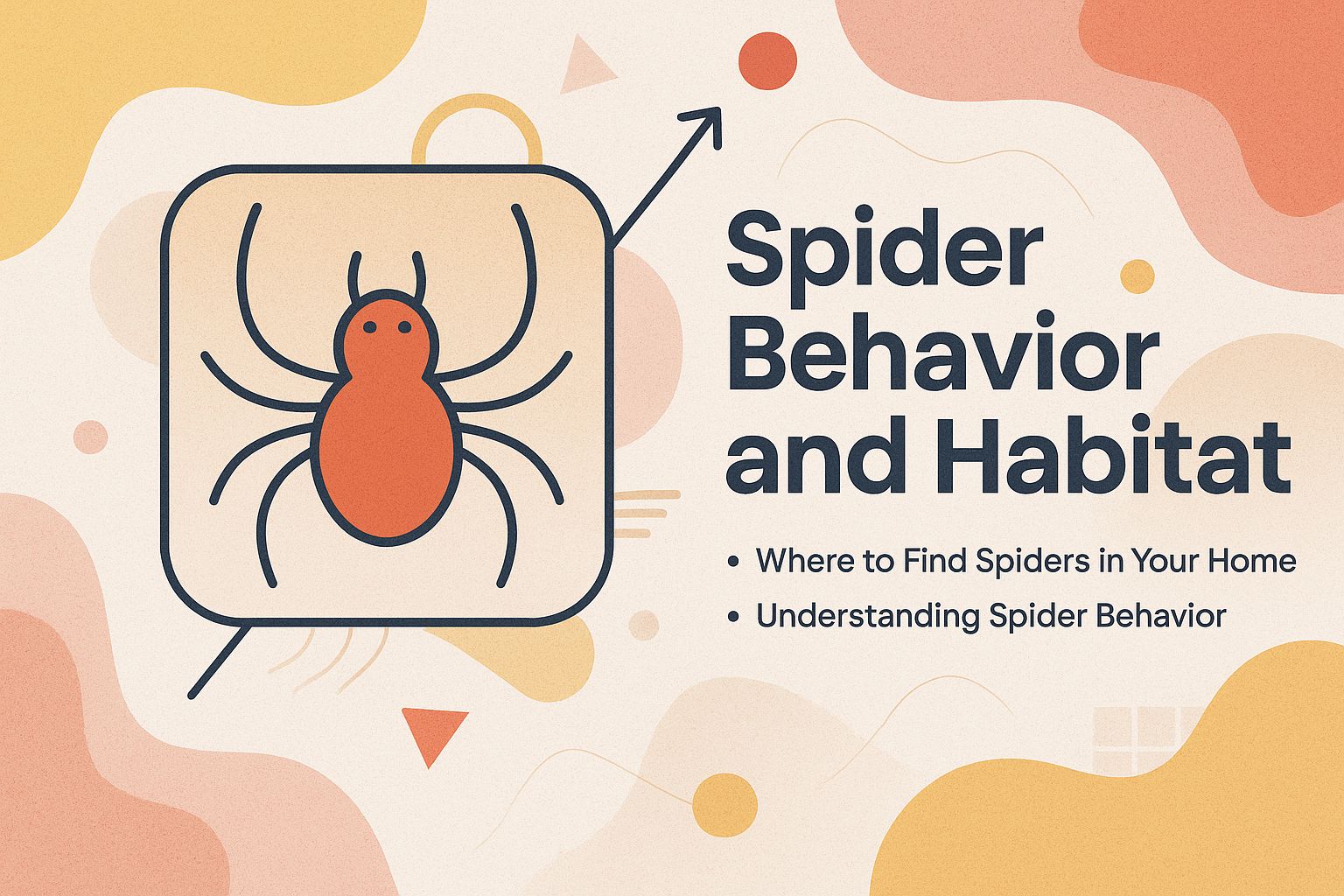
Where to Find Spiders in Your Home
Common indoor spider habitats include dark corners, basements, and attics, where they can thrive undisturbed.
To effectively inspect these areas for spider presence, follow these steps:
- Use a flashlight to light up dark areas.
- Carefully check behind furniture.
- Examine window frames.
Look for silk webs, as their presence usually indicates spider activity.
To maintain a spider-free environment, consider a checklist:
- Regularly declutter.
- Seal cracks and gaps.
- Keep exterior lights off at night to reduce insect attraction.
- Use natural repellents like peppermint oil.
Consistent monitoring and preventive measures can significantly reduce indoor spider encounters.
Understanding Spider Behavior
Learning about spider behavior, such as web-building and hunting techniques, aids in recognizing species and their roles in the ecosystem.
For example, orb-weaver spiders make detailed, round webs that catch flying insects, showcasing their insectivorous habits. You can usually find these webs in gardens or forests.
In contrast, wolf spiders are ground hunters, relying on speed and stealth to catch their prey without webs.
Learning about these behaviors helps identify species and shows how they contribute to the environment, such as controlling pests.
Noticing when certain animals, like funnel-web spiders that are mostly active at night, can improve efforts to identify them in nature.
Assessing the Danger Level
It’s necessary to know if a spider can be harmful to handle situations safely and improve spider safety measures.

Venomous vs. Non-Venomous Spiders
Learning to tell the difference between venomous and harmless spiders can help avoid panic and lead to the right actions when you see them.
One key characteristic is the coloration and markings; for instance, the black widow has a glossy black body with a distinctive red hourglass marking. In contrast, common house spiders are often brown and may have subtle striping.
Behavior also differs; venomous spiders, like the brown recluse, tend to be reclusive and prefer dark spaces, while non-venomous types may be more active in open areas. Knowing these traits can help you identify and respond appropriately when encountering these arachnids.
Symptoms of Spider Bites and First Aid
Identifying spider bite symptoms is important for quick medical treatment for bites, especially for bites from venomous spiders.
Common symptoms of spider bites include redness, swelling, and pain at the site.
For black widow bites, look out for strong stomach pain, muscle cramps, and usually, a red spot that looks like a target. In contrast, brown recluse bites may manifest as a painful sore that worsens over time, often resembling an ulcer.
First aid includes:
- Cleaning the area with soap and water
- Applying a cool compress
- Taking pain relievers if necessary
Get medical help right away if your symptoms get worse, like trouble breathing or a rash that spreads, because these might mean a serious reaction.
Preventing Spider Infestations
Good prevention steps can greatly lower the chance of spider problems in your house. For those looking for specific strategies, see also: Arachnid Alert: Effective Strategies for Spider Pest Control, which offers in-depth advice on managing these pests.
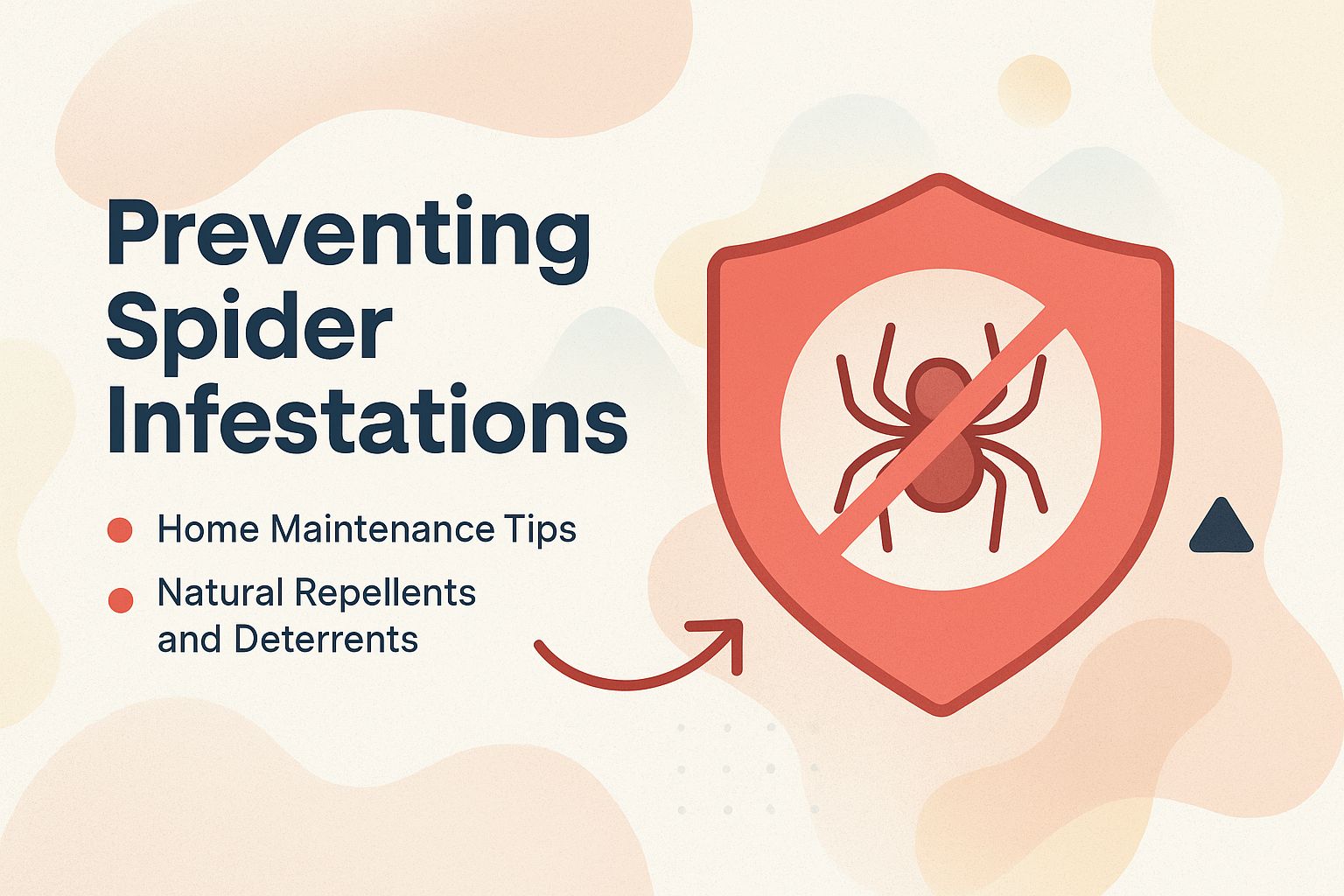
Home Maintenance Tips
Regular home maintenance can drastically reduce spider habitats and help in spider prevention, minimizing encounters and infestations.
A key action is to seal cracks around windows and doors, using a quality caulk specifically designed for exterior use.
Regularly inspect your basement and attic; these areas are often overlooked and can harbor pests. Cleaning up reduces places where common spiders can hide and helps you see any infestations.
Look for indications of pests regularly, about every three months. Tools like a vacuum can help remove spiders gracefully, while a flashlight can aid in spotting dark corners where they might reside.
Natural Repellents and Deterrents
Utilizing natural spider repellents like essential oils can deter spiders without the use of harmful chemicals, promoting a safer indoor environment.
Effective natural repellents include:
- Peppermint oil
- Vinegar
- Citrus
- Spider traps
For peppermint oil, mix 10-15 drops with water in a spray bottle and apply it around windows and entry points weekly; studies show it can reduce spider sightings by up to 80%.
Applying undiluted vinegar in corners and small areas disrupts spider smells, reducing their presence in your home.
Citrus peels, especially orange and lemon, can be placed in areas where spiders frequent; the strong scent is a natural deterrent. Using regularly keeps it working well over time.
What to Do If You Encounter a Spider: Safety Precautions and First Aid for Bites
Knowing how to safely deal with a spider situation is important to reduce arachnophobia and keep children and pets safe.
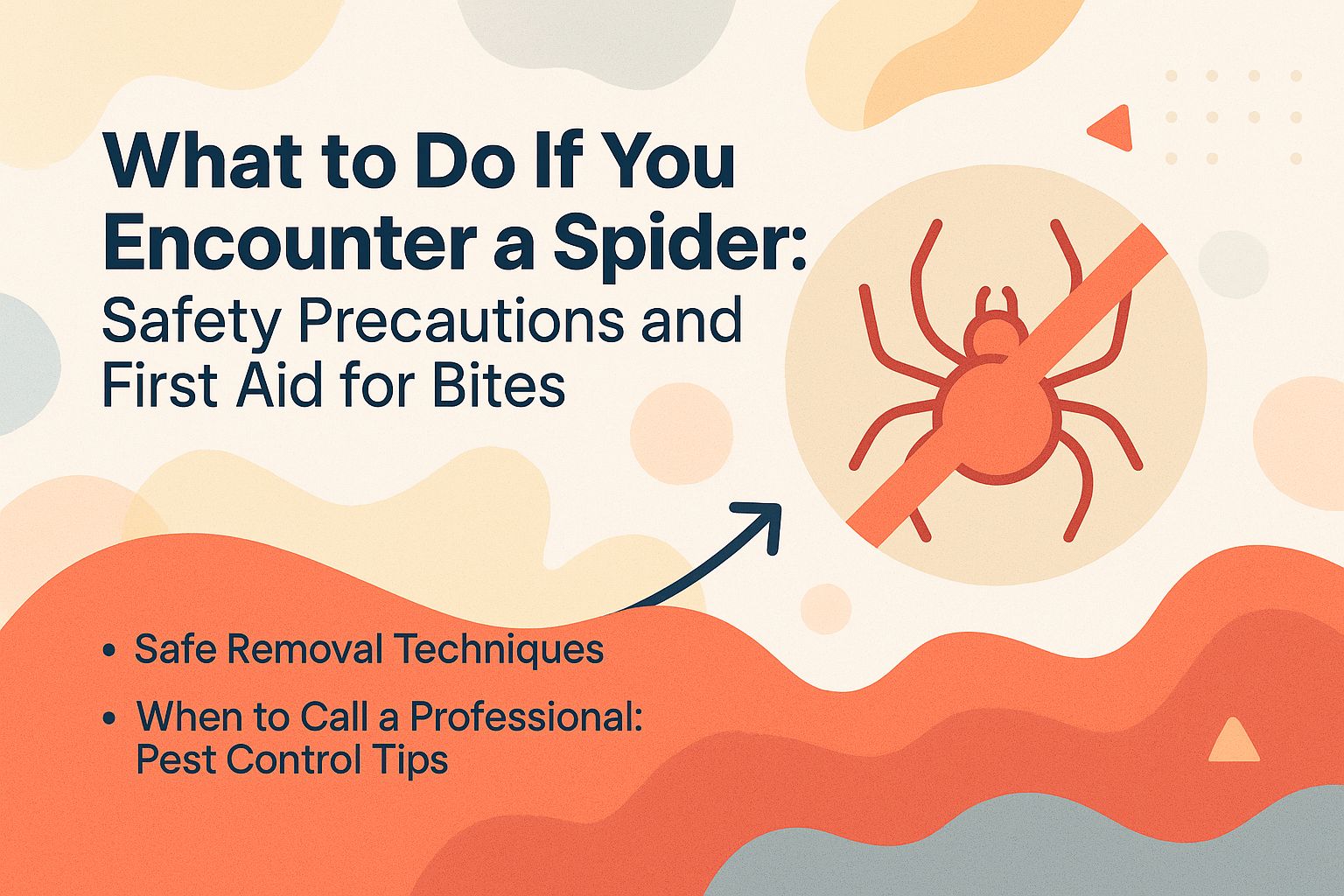
Safe Removal Techniques
Using careful removal methods allows you to deal with spiders without causing harm to you or the spider.
When to Call a Professional: Pest Control Tips
Knowing when to call a pest control professional can save time and prevent potential dangers from venomous spiders.
Look for specific signs that indicate a problem. If you often find dangerous spiders such as black widows or brown recluses in your home, it’s important to address the issue, considering the behavior of spiders and the effect on the environment.
Other indicators include a web-heavy environment, particularly in corners or attics, and the presence of spider egg sacs, which relate to the spider lifecycle.
When picking a pest control company, check if they have a license and insurance, and ask about their methods to confirm they use treatments that are both safe and effective for common and outdoor spiders.
Online reviews and referrals from neighbors can also help in selecting a reliable provider for spider conservation efforts.
Resources for Further Learning: Spider Education and Research
Learning about how to find and handle spiders helps you know more.
Books and Websites on Spider Identification: Spider Behaviour Studies and Myth Debunking
Many books and websites offer detailed information on identifying spiders and spider myths, suitable for all knowledge levels.
“For beginners, “Spiders of North America” has clear pictures and easy-to-understand descriptions of spider characteristics, making it simple for casual readers.”
The “American Arachnological Society” website is a complete source of information, offering various articles that focus on different species, their geographic distribution, and where they live.
Readers who want more information can read “The Book of Spiders,” which provides detailed information on spider classification, spider reproduction, and study.
The iNaturalist platform lets users share spider photography and get help identifying them from the community, which helps improve both learning and interest in the study of spiders.
Local Extension Services and Experts: Spider Resources and Nature Blogs
Contacting local extension services can offer useful tips and help with identifying and handling spiders.
To find your local extension service, visit the website of your state university or use the National Institute of Food and Agriculture’s directory.
Once on the site, look for the “Extension” or “Outreach” section.
When reaching out, consider sharing clear photos of the spiders and details about your specific issues. Experts can quickly identify species and suggest control methods.
Getting help from these experts will give you specific guidance for pest issues and situations in your area.
About the Author
Written by Kevin McAlister, a Cornell University graduate with a degree in agricultural biology, entomology, and bioagricultural sciences. I’m the owner of a successful pest control company in Delaware and a writer and editor for Pest Extinct. For the past nine years, I’ve specialized in sustainable, science-based pest control solutions for residential and commercial clients across the Northeast.

Leave a Reply